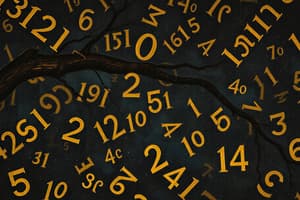Podcast
Questions and Answers
What is a complex number?
What is a complex number?
- A number greater than zero
- A number with a real part only
- A number that consists of both real (a) and imaginary (bi) parts (correct)
- A negative number
What is the absolute value?
What is the absolute value?
The distance between a number and zero.
Define an expression in mathematics.
Define an expression in mathematics.
A representation of a quantity that may contain numbers, variables, or operation symbols.
What is a variable?
What is a variable?
What is a term in mathematics?
What is a term in mathematics?
Define a polynomial.
Define a polynomial.
What does the degree of a polynomial refer to?
What does the degree of a polynomial refer to?
What is the leading coefficient?
What is the leading coefficient?
What are the factors of a monomial?
What are the factors of a monomial?
What is a prime polynomial?
What is a prime polynomial?
If $ab = 0$, then $a = 0$ or $b = 0$.
If $ab = 0$, then $a = 0$ or $b = 0$.
What are zeros in a function?
What are zeros in a function?
What are x-intercepts?
What are x-intercepts?
What is a vertical line represented by?
What is a vertical line represented by?
What is a horizontal line represented by?
What is a horizontal line represented by?
Define an inequality.
Define an inequality.
What is the domain of a function?
What is the domain of a function?
What is the range of a function?
What is the range of a function?
What is function notation?
What is function notation?
What represents direct variation?
What represents direct variation?
Define inverse variation.
Define inverse variation.
What does joint variation represent?
What does joint variation represent?
Define an arithmetic sequence.
Define an arithmetic sequence.
What is a geometric sequence?
What is a geometric sequence?
Define a permutation.
Define a permutation.
What is a combination?
What is a combination?
Define a z-score.
Define a z-score.
What is a literal equation?
What is a literal equation?
What is the standard form of a quadratic equation?
What is the standard form of a quadratic equation?
What is the vertex of a quadratic function?
What is the vertex of a quadratic function?
What does the quadratic formula do?
What does the quadratic formula do?
What are increasing/decreasing intervals?
What are increasing/decreasing intervals?
What are extrema in a function?
What are extrema in a function?
Define end behavior in terms of functions.
Define end behavior in terms of functions.
What is the linear parent function?
What is the linear parent function?
What is the quadratic parent function?
What is the quadratic parent function?
Define the absolute value parent function.
Define the absolute value parent function.
What is the square root parent function?
What is the square root parent function?
What is the cubic parent function?
What is the cubic parent function?
Define the cube root function.
Define the cube root function.
What is the rational parent function?
What is the rational parent function?
What does the exponential growth parent function represent?
What does the exponential growth parent function represent?
What is the logarithmic parent function?
What is the logarithmic parent function?
What does translation of a parent function involve?
What does translation of a parent function involve?
What does dilation of a parent function refer to?
What does dilation of a parent function refer to?
Define reflection of a parent function.
Define reflection of a parent function.
What is the inverse of a function?
What is the inverse of a function?
Define continuity in functions.
Define continuity in functions.
What is an asymptote?
What is an asymptote?
Define a hole in graphing functions.
Define a hole in graphing functions.
What is the fundamental counting principle?
What is the fundamental counting principle?
What is the permutation formula?
What is the permutation formula?
What is the combination formula?
What is the combination formula?
What does ∑ (capital sigma) represent?
What does ∑ (capital sigma) represent?
Define the empirical rule in statistics.
Define the empirical rule in statistics.
Flashcards are hidden until you start studying
Study Notes
Complex Numbers and Absolute Value
- A complex number is represented as a ± bi, combining real (a) and imaginary (bi) parts.
- Absolute value reflects the distance of a number from zero on the number line.
Algebraic Concepts
- An expression constitutes numbers, variables, and operation symbols.
- Variables, like x or y, represent quantities that can adjust in mathematical scenarios.
- Terms can be a single number/variable or a product of both, separated by addition or subtraction.
Polynomials and Their Characteristics
- Polynomials encompass algebraic expressions such as monomials, binomials, and trinomials.
- The degree of a polynomial is defined by the largest exponent or sum of exponents in its terms.
- The leading coefficient is the coefficient of the first term when written in decreasing order of exponents.
Functions and Graphs
- Zeros of a function indicate where the function equals zero (f(x) = 0).
- X-intercepts occur where the graph crosses the x-axis.
- Vertical lines have an equation x = a with undefined slopes; horizontal lines are y = c with a zero slope.
Relationships and Variations
- Inequalities compare two quantities in algebraic sentences.
- Domain refers to all possible values that an independent variable can take.
- Range represents all possible values of a dependent variable.
Variations Defined
- Direct variation follows the formula y = kx, indicating a constant ratio between x and y.
- Inverse variation is expressed as k = xy, indicating a constant product relationship.
- Joint variation presents y = kxz, where one variable depends on two or more others.
Sequences and Combinatorics
- An arithmetic sequence has a consistent difference between consecutive terms.
- A geometric sequence involves multiplying each term by a constant ratio.
- Permutations are ordered arrangements; combinations involve selection without regard to order.
Statistical Measures
- Z-score indicates how many standard deviations an element is from the mean.
- Literal equations predominantly consist of variables, often used to express relationships.
Quadratic Functions
- Standard form for quadratic equations is ax² + bx + c = 0.
- Vertex of a quadratic function can be found using special formulas based on its standard and vertex forms.
- The quadratic formula x = -b ± √(b² - 4ac)/2a solves quadratic equations.
Function Behavior
- Increasing/decreasing intervals characterize the behavior of functions over specified ranges.
- Extrema denote the maximum and minimum values of functions, either locally or globally.
- End behavior describes the function's value as x approaches positive or negative infinity.
Parent Functions
- Parent functions represent the simplest forms:
- Linear: f(x) = x
- Quadratic: f(x) = x²
- Absolute Value: f(x) = |x|
- Square Root: f(x) = √x
- Cubic: f(x) = x³
- Cube Root: f(x) = ³√x
- Rational: f(x) = 1/x
- Exponential Growth: f(n) = bⁿ (b > 1)
- Logarithmic: f(x) = logₙ(x) (n > 1)
Transformations and Inverses
- Translations of parent functions shift graphs horizontally/vertically.
- Dilations stretch or compress graphs either vertically or horizontally.
- Reflections flip graphs over axes, altering their orientations.
Continuity and Discontinuities
- Continuity indicates a function is unbroken at all points in its domain.
- Asymptotes are lines that approach a curve but do not intersect it, indicating discontinuity.
- Holes in functions occur where both the numerator and denominator are zero, causing discontinuity.
Counting Principles
- Fundamental counting principle: If there are m ways for one event and n ways for another, there are m ∙ n ways for both.
- Permutations and combinations have specific formulas: nPr for permutations and nCr for combinations.
Statistical Distribution
- The empirical rule (68-95-99.7 rule) describes the distribution of elements in a normal distribution curve.
Studying That Suits You
Use AI to generate personalized quizzes and flashcards to suit your learning preferences.




